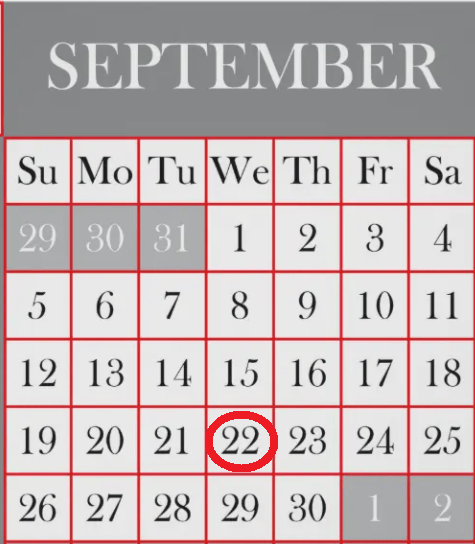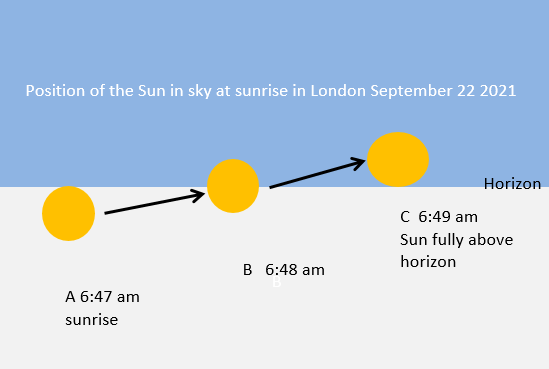In 2021 September 22 is the date of the September equinox and is also the first day of autumn (or the first day of spring if you’re one of my readers in the Southern Hemisphere). In this post I’ll talk about the equinoxes and discus the commonly held view that they are the two days in the year when all places on Earth have exactly 12 hours of daylight and 12 hours of darkness.

What is an equinox?
The origin of the word equinox comes from two Latin words aequus (equal) and nox (night). This definition suggests that at an equinox the length of the day and night are equal. However, the precise astronomical definition of an equinox is slightly different.
.
The diagram above shows the Earth going around the Sun in its orbit.
- At the December solstice (point A in the diagram) the North Pole is tilted further away from the Sun than at any other time of the year, and the South Pole is tilted nearest the Sun. In the Northern Hemisphere the period of darkness is longest compared with the period of daylight, and in the Southern Hemisphere the reverse applies.
- At the June solstice (point C) it is exactly the opposite of the winter solstice – the North Pole is now tilted nearest to the Sun. So, the Northern Hemisphere experiences the longest period of daylight.
- There are two times a year (B and D in the diagram) when the neither the North Pole nor the South Pole are tilted towards the Sun and these times are the equinoxes. If we take two places with the same latitude, one of which is north of the equator and the other one south of the equator and roughly the same longitude (for example Tokyo and Adelaide, South Australia) they will both have the same amount of daylight at the equinox.
On what date do the equinoxes occur?
The Earth moves in an elliptical orbit around the Sun. This means that it has further to travel in its orbit between the March equinox and the September equinox than in the return leg of its journey from September to March. The two equinoxes are therefore not exactly half a year apart. The time between the March equinox and the following September equinox is around 186 days, whereas the time between the September equinox and the following March equinox is only 179 days.
For 2021/22 the dates and time of the equinoxes are
- 20 March 2021 at 09:37
- 22 September 2021 at 19:41
- 20 March 2022 at 15:33
- 23 September 2022 01:04
All times are in GMT (which is more correctly known as UTC). So, depending on your time zone, the equinoxes will occur at a different time and even a different date.
Are there 12 hours of daylight at an equinox?
When we answer this question, we need to think about what mean by the term: ‘hours of’daylight’?
Do we consider twilight, the time just after sunrise or just before sunset when it is not completely dark, to be daylight?
Or do we consider daylight as being the time when the Sun is above the horizon?
If we use the definition of ‘daylight’ as being the interval between sunrise and sunset, then for two reasons there are actually slightly more than 12 hours of daylight at the equinox everywhere in the world.
- Firstly, the definition of sunrise is when the first light from the Sun’s rays reaches above the horizon, not when the centre of the Sun is above the horizon. The diagram below shows the path of the Sun’s disc around sunrise at the equinox in London. In the early morning, the time when the half of the Sun is above the horizon and half below the horizon is 6:48 am, shown as B in the diagram, but sunrise is about a minute before this time.

Similarly, in the early evening the time when half of the Sun is above the horizon and half below the horizon is 6:56 pm, B in the diagram, but sunset – when the last light from the Sun’s rays is above the horizon – is about a minute after this time.

- Secondly, when the Sun is just below the horizon the Earth’s atmosphere bends the Sun’s rays, causing them to appear just above the horizon. This bending of light is known as refraction and has the effect of slightly extending the hours of daylight.
Taken together, these two effects mean that there are slightly more than 12 hours of daylight at the equinox. The date on which there (almost) exactly 12 hours of daylight and 12 hours of darkness is called the equilux (although this term is not widely used and is so rejected by my spelling checker 😉 ). In London the equilux occurs on 25 September, three days after the equinox. For other locations on the Earth it will occur on different dates
When does Autumn begin?
Although I started this post by saying that September 22 is the first day of the Northern Hemisphere autumn, in the UK there is an alternative definition of autumn used by meteorologists and widely used by the public as well. Meteorological autumn consist of the months of September, October and November and so starts on September 1 and finishes on November 30. Similarly, meteorological winter is December/January/February, spring is March/April/May and summer June/July/August. To many people, it makes more sense for the middle of December with its low temperatures and short hours of daylight to be in winter than in autumn!


I am native from the Southern Hemisphere. Climate change there is equinoxious. But the story of Easter Island teaches us not to fall into the trap of the Natural Fallacy.
LikeLike
🙂
LikeLike
Never heard of the equilux before. I like that term. It surprises me, sometimes, what words spellcheck will accept or reject.
LikeLiked by 1 person
I guess it also depends on the local horizon (mine is the Blue Mountains, west of Sydney) and your elevation above or below it.
A good read as always, Steve.
🙃
LikeLike
Hi GB,
Yes, you’re luckier than us at around sea-level, in having a slightly longer stretch of daylight, regardless of what the season is. (Of course if you’re an astronomer, you might relocate to a mountain top for a clearer view through thinner atmosphere, but you’d have to put up with a slightly shorter period of darkness.)
David.
LikeLike
Thank you Ggreybeard
LikeLike
Hi Steve,
Yes it’s regrettable that the name is rather misleading. If we wanted something a bit closer linguistically, we might consider ‘equicline’ (slightly anglicized Latin), or ‘isoclize’ (adapted Greek).
Regards, David.
PS: But on second thoughts, the appearance of a new word -even in the interests of accuracy- tends to annoy readers. ( “It must needs be that offences come, but woe to that man by whom the offence cometh !” )
LikeLike
An interesting thought!
LikeLike